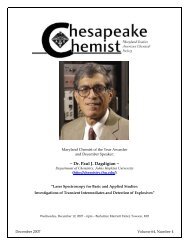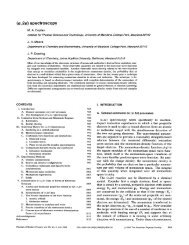Graduate Study in - Chemistry - Johns Hopkins University
Graduate Study in - Chemistry - Johns Hopkins University
Graduate Study in - Chemistry - Johns Hopkins University
Create successful ePaper yourself
Turn your PDF publications into a flip-book with our unique Google optimized e-Paper software.
Joel R. Tolman<br />
Biophysical <strong>Chemistry</strong><br />
jtolman@jhu.edu<br />
Ph.D., Yale <strong>University</strong><br />
Human Frontier<br />
Postdoctoral Fellow,<br />
<strong>University</strong> of Toronto<br />
Postdoctoral, École<br />
Polytechnique Fédérale de<br />
Lausanne<br />
With<strong>in</strong> the past two decades, Nuclear Magnetic Resonance spectroscopy<br />
(NMR) has become a powerful technique for the study of<br />
macromolecular structure and dynamics <strong>in</strong> the solution state. Research<br />
<strong>in</strong> my lab will be concerned with both the development and application<br />
of novel NMR techniques for study<strong>in</strong>g the complex <strong>in</strong>teractions that<br />
underlie biological function. Of particular <strong>in</strong>terest are studies of molecular dynamics,<br />
the nature of <strong>in</strong>termolecular recognition and the quaternary organization of multidoma<strong>in</strong><br />
prote<strong>in</strong> systems.<br />
The full repertoire of multidimensional NMR methodology will be employed<br />
to study these problems, <strong>in</strong>clud<strong>in</strong>g sp<strong>in</strong> relaxation, scalar coupl<strong>in</strong>g, NOE, and<br />
hydrogen exchange experiments. However, the primary approach will be centered<br />
around recently developed techniques for the measurement of Residual Dipolar<br />
Coupl<strong>in</strong>gs (RDCs) <strong>in</strong> macromolecules. These RDCs, which are normally averaged to<br />
zero <strong>in</strong> solution, are made observable by <strong>in</strong>troduc<strong>in</strong>g a very weak degree of alignment<br />
of the biomolecule relative to the magnetic field. This alignment is typically achieved<br />
by dissolv<strong>in</strong>g the prote<strong>in</strong> or nucleic acid along with a suitable co-solute, such as<br />
bacteriophage particles. The result<strong>in</strong>g RDCs are relatively easily measured and<br />
represent an abundant source of highly precise <strong>in</strong>formation on the relative<br />
orientations of different <strong>in</strong>ternuclear ‘bonds’ with<strong>in</strong> the molecule. Intrigu<strong>in</strong>gly, RDCs<br />
also exhibit sensitivity to molecular motions on the nsec-sec timescales, dur<strong>in</strong>g which<br />
many functionally important motions occur. These motional timescales have<br />
traditionally been very difficult to access experimentally, and thus a major objective<br />
will be to develop RDC-based techniques to enable the study of these motions.<br />
One of the applications of these techniques will be to <strong>in</strong>vestigate the<br />
quaternary organization of tetrameric ubiquit<strong>in</strong>. Tetramers of the prote<strong>in</strong> ubiquit<strong>in</strong><br />
can assume a multi-faceted role <strong>in</strong> cellular signal-transduction mechanisms, which<br />
depends on how they are l<strong>in</strong>ked together. A major goal will be to ga<strong>in</strong> <strong>in</strong>sights <strong>in</strong>to<br />
the nature of this important and versatile signal through studies of its solution state<br />
conformations. In addition, efforts are ongo<strong>in</strong>g to develop methodology for the<br />
simultaneous determ<strong>in</strong>ation of both the 3-dimensional structure and a detailed<br />
description of the dynamics of a prote<strong>in</strong>. A closely related objective is to develop the<br />
capability of us<strong>in</strong>g NMR to rapidly determ<strong>in</strong>e the backbone fold of a prote<strong>in</strong> to<br />
moderate resolution, which would represent an important contribution to current<br />
structural genomics <strong>in</strong>itiatives.<br />
Selected publications <strong>in</strong>clude:<br />
Tolman, J.R., “Dipolar Coupl<strong>in</strong>gs as a Probe of Molecular Dynamics and Structure <strong>in</strong> Solution,”<br />
Curr. Op<strong>in</strong>. Struct. Biol. 2001, 11, 532-539.<br />
Al-Hashimi, H.M.; Tolman, J.R.; Majumdar, A.; Gor<strong>in</strong>, A.; and Patel, D.J., “Determ<strong>in</strong><strong>in</strong>g<br />
Stoichiometry <strong>in</strong> Homomultimeric Nucleic Acid Complexes Us<strong>in</strong>g Magnetic Field Induced Residual<br />
Dipolar Coupl<strong>in</strong>gs,” J. Am. Chem. Soc. 2001, 123, 5806-5807.<br />
Tolman, J.R.; Al-Hashimi, H.M.; Kay, L.E.; and Prestegard, J.H., “Structural and Dynamic Analysis<br />
of Residual Dipolar Coupl<strong>in</strong>g Data for Prote<strong>in</strong>s,” J. Am. Chem. Soc. 2001, 123, 1416-1424.<br />
Tolman, J.R.; Flanagan, J.M.; Kennedy, M.A.; and Prestegard, J.H., “NMR Evidence for Slow<br />
Collective Motions <strong>in</strong> Cyanometmyoglob<strong>in</strong>,” Nature Struct. Biol. 1997, 4, 292-297.<br />
20 <strong>Graduate</strong> <strong>Study</strong> <strong>in</strong> <strong>Chemistry</strong> at The <strong>Johns</strong> Hopk<strong>in</strong>s <strong>University</strong>







